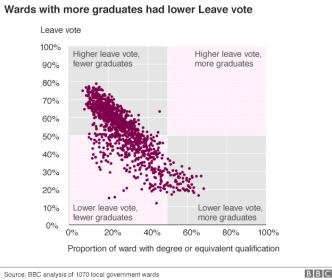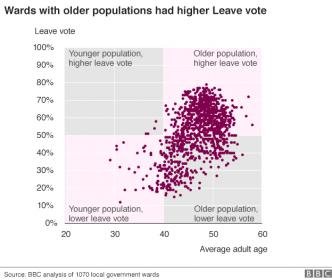The BBC has obtained a more localised breakdown of votes from nearly half of the local authorities which counted EU referendum ballots last June.
This information provides much greater depth and detail in explaining the pattern of how the UK voted. The key findings are:
* The data confirms previous indications that local results were strongly associated with the educational attainment of voters -
populations with lower qualifications were significantly more likely to vote Leave. (The data for this analysis comes from one in nine wards)
*
The level of education had a higher correlation with the voting pattern than any other major demographic measure from the census
* The age of voters was also important, with older electorates more likely to choose Leave
* Ethnicity was crucial in some places, with ethnic minority areas generally more likely to back Remain.
However this varied, and in parts of London some Asian populations were more likely to support Leave
* The combination of education, age and ethnicity accounts for the large majority of the variation in votes between different places
* Across the country and in many council districts we can point out stark contrasts between localities which most favoured Leave or Remain
* There was a broad pattern in several urban areas of deprived, predominantly white, housing estates towards the urban periphery voting Leave, while inner cities with high numbers of ethnic minorities and/or students voted Remain
* Around 270 locations can be identified where the local outcome was in the opposite direction to the broader official counting area, including parts of Scotland which backed Leave and a Cornwall constituency which voted Remain
* Postal voters appear narrowly more likely to have backed Remain than those who voted in a polling station
The national picture
Education
 Age
Age
 Ethnicity
Ethnicity
Ethnicity is a smaller factor, but one which also contributed to the results. Adding that in means that now 83% of the variation in the vote between wards is explained. White populations were generally more pro-Leave, and ethnic minorities less so. However, there were some interesting differences between London and elsewhere.
[......]
Overview
This powerful link to educational attainment could stem from the lower qualified tending to feel less confident about their prospects and ability to compete for work in a competitive globalised economy with high levels of migration.
On the other hand some commentators see it as primarily reflecting a "culture war" or "values conflict", rather than issues of economics and inequality. Research shows that non-graduates tend to take less liberal positions than graduates on a range of social issues from immigration and multi-culturalism to the death penalty.
The former campaign director of Vote Leave, Dominic Cummings, argues that the better educated are more prone to holding irrational political opinions because they are more driven by fashion and a group mentality.
Of course this assessment does not imply that Leave voters were almost all poorly educated and old, and Remain voters well educated and young. The Leave side obviously attracted support from many middle class professionals, graduates and younger people. Otherwise it couldn't have won.
While there was undoubtedly a lot of voting which cut across these criteria, the point of this analysis is to explore how different social groups most probably voted - and it is clear that education, age and ethnicity were crucial influences.
After these three key factors are taken into account, adding in further demographic measures from the census does little to increase the explanation of UK-wide voting patterns.
However, this does not reflect the distinctively more pro-Remain voting in Scotland, since we are short of Scottish data at this geographical level. It is clear as well that in a few specific locations high student numbers were also very relevant.
To a certain extent, using the level of educational qualifications as a measure combines both class and age factors, with working class and older adults both tending to be less well qualified
But the association between education and the voting results is stronger than the association between social or occupational class and the results. This is still true after taking the age of the local population into account.
This suggests that voters with lower qualifications were more likely to back Leave than the better qualified, even when they were in the same social or occupational class.
The existence of a significant connection between Leave voting and lower educational qualifications had already been suggested by analysis of the published referendum results from the official counting areas.
The data we have obtained strengthens this conclusion, because voting patterns can now be compared to social statistics from the 2011 census at a much more detailed geographical level than by the earlier studies.
The BBC analysis is also consistent with opinion polling (for example, from Lord Ashcroft, Ipsos Mori and YouGov) that tried to identify the characteristics of Leave and Remain voters.












